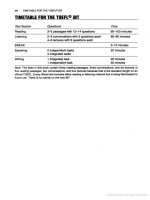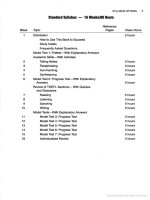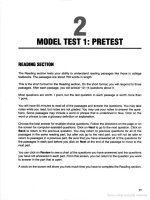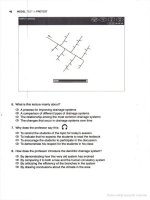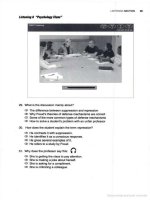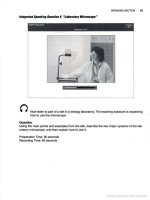Toefl ibt internet based test 2006 - 2007 part 60 pps
Bạn đang xem bản rút gọn của tài liệu. Xem và tải ngay bản đầy đủ của tài liệu tại đây (950.72 KB, 7 trang )
MODEL
TEST
6IREAOING
SECTION
4
07
MODEL
TEST
6:
TEST
READING
SECTION
The Reading section lesls your ability
to
understand readi
ng
passages like lhose in college
textbookS.
Th
e passages are about 700 words in length.
This
Is the long format for l
he
Reading section. On the iong format, you will respond 10 five
passages. After each passage, you will answer
12-
14 questioos about it. Only three passages
will be graded.
The
other passages are part of an exerimen
ta
l section for future tests. Because
you
will
nol
know which passages will be graded, you must try
to
do
your besl on all of them.
MoSI
questions are worth 1 point. but the last queslion in each passage is worth more than
1 point.
You
will have 100 minutes
to
read all of Ihe passages and answer the questions.
You
may take
notes
while you read. but notes are not graded.
You
may use your notes to answer the ques·
tions.
Some passages may il'lClude a word or phrase that is underlined In blue. Click on t
he
word or phrase
to
see a glossary definition or explanation.
Choose the best answer
fo
r multiple-choice questions. Follow the directions on the page or on
the screen
fo
r computer-assisted question
s.
Click on
Next
to
go
to
the next question. Click on
Back
10
return
to
the previous question.
You
may rettlm
10
previous questions lor all of I
he
passages
in
the same reading part, but after you
go
to th
e next part, you will not
be
able to
return to passages
In
a previous part.
Be
sure
th
at you have answer
ed
all
01
the questions
lor
the passages In each part before you ctick on
Next
at the end of the passage to move to the
next part.
Yo
u can click on Re
view
to see a chart of the questions you have answered and the questions
you have nol
answered
In
each part. From this screen, you can return to the question you want
to answer in the pa
rt
Ihat is open.
A
clock on the screen will show yoo
how
much time yoo have to complete the Reading section.
)pynghl mater I
408
MORE
MODEL
TESTS
PART
I
Rudin, t
"fI,tlc
1M
E
",.
".,.,
-+
When
you
hear
someone
bubbling
enthusiastlcally
about
an
exotic
apeelea
, you
Can
safely
betlhe
speaker isn't
an
ecologist. This is a name for a
resident
01
an
established
. community that was deliberately
or
accidentally
moved
lrom
its home range and became established elsewhere. Unlike most
Imports,
which can't take hold outside their
home
range,
an
exotic species per-
manently insinuates "
into a new community.
Sometimes the additions are
hannless
and
even have beneficial effects.
More
olten, they make native species endangered apeeles, which by defini-
tion are extremely vulnerable to extinction.
01
all species on the rare
or
endan-
gered
lists
or
that
recently
became
extinct
, close to
70
percent owe
the
ir
precarious
ex
istenes
or
daml58 to displacement
by
exotic species. Two exam-
ples are included here
to
illustrate the problem.
During the
18OOs,
BritiSh settlers in Australia just couldn't with the
koalas and kangaroos,
so
they
started to import familiar animals from their
homeland.
In 1859, in
what
would
be
the start
of
a wholesale disaster, a north-
ern Australian landowner Imported and then released
two
dozen wild European
rabbits
(Oryctolagus cuniculus). Good lood and good sport
hunting-that
was
the
Idea. An ideal rabbit habitat with
no
naMal
predators was the reality.
Six
years tater, the landowner had killed 20,000 rabbits and was besieged
by
20,000
rn04"e
.
The
rabbits displaced livestock, even kangaroos.
Now
Aus-
tralia has 200 to 300 million hippilyhopping through
the
southern half
of
the
country. They overgraze perennial gras58s in
good times
and
strip bark from
shrubs and
trees during droughts.
You
know
where they've been; they trans-
fonn
grasslands and shrublands Into eroded deserts. They have been Shot
and
poisoned. Their warrens
have
been
plOWed
under, fumigated, and dynamited.
Even when
all-out assaults reduced their population size by 70 percent, the
rapidly reproducing Imports made a comeback In less than a year.
Old
the con·
struction
of
a 2,QOO.mile-long fence protect western Australia? No. Rabbits
made
it to the other side before workers finished the fence.
-+
In 1951 , government workers Introduced a myxoma virus by way
of
mildly
infected South American rabbits, its nonnal hosts. This virus causes
myxo-
matosis.
The
disease
has
mild effects
on
South American rabbits
that
ooevolved with the virus
but
nearly always had lethal effects on O. cuniculus.
Biting Insects, mainly mosquitoes
and
fleas, quickly transmit the virus from host
to host. Having
no
ooevolved defenses against the novel virus, the European
rabbits died
In droves.
But.
as you might expect, natural
selection
has since
favored rapk:lgrowth of populations
of
O. cuniculus resistant to the virus.
)pynghtoo
maier I
MOOEl
TEST 6lAEAOING SECTION .011
-+
In
1
991
.
on
an unint'labited island in Spencer Gull. Australian researchers
released a population of rabbits that they had injected with a calcivirus. The
rabbits died
quickly
and
relatively painlessly from blood clots In their lungs,
hearts, and kidneys.
In
1995, the test virus escaped from the Island, possibly on
insect vectors. It has been killing 80 to 95 percent of the adutl rabbits
In
Aus-
tralian regions.
At
this writing. researchers are now questioning whether the
calcivirus should be used on a widespread scale, whether
it
can jump bound-
aries and infect animals other than rabbits (such as humans), and what the
tong-term will
be.
A vine called kudzu (Pueraria /obata) was deliberately imported Irom Japan
to the United
States, where it faces no serious threats Irom herbivores,
pathogens, or competitor plants.
In
lemperate parts of Asia.
it
is a well-behaved
legume with a well-developed root system. It seemed like a good idea to use it
to
control erosion on hills and highway embankments in the southeastern
Unit
ed
State
s.1AI
With nothi
ng
to stop
it,
though, kudzu's shoots grew a third
01
a meter per day. Vines now blanket streambanks, trees, tetephone poles,
houses, and almost everything else in their path. Attempts
to
dig up or bum
kudzu are hIIile. Grazing goats and herbicides help, but goats eat other plants,
t
oo
, and herbicides contaminate water supplies.
IBl
Kudzu could reach the
Great Lakes
by
t
he
year 2040.
-+
On the bright side, a Japanese firm is constructing a kudzu farm and pro-
cesslng plant
In
Alabama. The idea is
to
export the starch to Asia, where the
demand currently the
supply.
1CI
Also, kudzu
may
eventually help
reduce logging
opera
tions.
!OJ
At the Georgia Institute of Technology,
researchers report thal kudZu
might become an alternatIVe source lor pape
r.
1. Based on the information in paragraph I , which of Ihe following besl explains t
he
term
-exotic species"?
CD
An
imals or plants on the rare species list
(D
A permanent reSident in an established communi
ty
<D A species that has been moved
to
a different communi
ty
~
An
Import that fails
10
thrive outside of its home range
Paragraph 1 is marked with an arrow [-+).
2. The
wOfd
i1seIf
In the passage refers to
CD
mosl lmports
<D new community
<D home range
~
exotic species
412
MORE
MOOEL
TE
STS
13. Direct
io
ns
:
An
Introduction
lor
a short summary of the passage appears below. Complete
the summary by
selectir'lg the THREE answer choices that mention the most important
points
In
the passage. Some sentences do not belong in the summary because they
express Ideas that are not Included
In
the passage or are minor points fr
om
the passage.
Th
is
question Is worth 2 points.
exotic
species
often
require
containment
becIIUH
they
displace
other
species
when they become
established
In
a
new
environment.
•
•
•
AnswerCholc.a
!al
Rabbits were able
10
cross a lence 2,000
miles long
that was constructed to keep
them out of western Australia.
101
Researchers may be able to develop
material from
the kudzu vine that will be
an alternative
to
wood pulp paper.
ml
Methods
to
control exotic species Include
fences, viruses, bum
ir'lg,
herbicides, nat·
ural predators, and harvesting.
ICl
Rabbits that were introduced in Australia
and kudzu which was introduced
In
the
United States, are examples
01
species
that caused problems.
PART
II
Rndl.,
2 "
hl.,lthlc
Art"
lEI
The problem
Is
that exotic species make
native
species vulnerable to extinction.
lEI
A virus that
Is
deadly to rabbits
may
have
serious effects for other animals.
~
The several millennia following 30,000 B.C. saw a powerful outburst
01
artis'
tic c
re
ativity. The artworks produced range from simple shell necklaces
to
human and animal forms in ivory. clay. and stone to monumental palntir'lgs,
engravings. and relief sculptures covering the huge
Wall
surlaces of caves.
From the moment in 1879
th
at cave palntir'lgS were discovered
al
Ahamlra.
scholars have wondered why the hunter·artlsts of the Old Stone Age decided
to
cover the walls
01
dark caverns with animal Images. Various answers have
been given,
including that they were mere decoration. but this theory cannot
explain the narrow
range
of
subjects or the Imtccesslbltity of many of the paint·
Ings. In
fact, the remoteness and difficulty
0'_
of many
of
the cave palnt-
ings and the fact they appear to have been used for centuries are precisely
what have led many scholars
to
suggest that the prehlstOfic hunters attributed
)pynqh ma r I
MODEL
TEST6IREAOINGSECTION
413
magical properties to the images they painted. Accordi
ng
to this argument, by
confining animals to
the
surfaces
of
their cave walls. the artists beli
eved
they
were
bringi
ng
the beasts under their control. Some have even hypothesized
that rituals
or
dances were performed in front
of
the images and that these
rites
selVed to improve the hunters' lucie Still others have stated that the painted
animals
may
have served
as
teaching tools 10 Instruct
new
hunters about the
character
of
the various species they would encounter
or
even to serve
as
tar-
gets for spearsl
By contrast,
some
scholars have argued that the magical purpose
01
the
paintings
was
not to
Mlti
t
iJ
the
destruct
ion
01
bison
and
olher
species
.
Instead, they betie
ve
prehistoric painters created animal images to assure the
survive/of the herds. Paleolithic
peop
l
es
depended on
lor
their food supply and
for their clothing.
L!l
A central problem for both the hunting-magic and food-
creation
theories
is
that lhe animals thaI seem 10 have been diet staples
of
Old
Stone Age peoples are not
~
most freque
nUy
portrayed.
[SJ
Other
scholars have sought to reconstruct an elaborate mythology based
on the cave paintings, suggesting that Paleolithic humans believed they had
animal ancestors.
Still others
ha
ve
equated certain species with men and oth-
ers with
women
and also
fOlJnd
sexual symbolism in
the
abstract signs that
sometimes accompany the images.
!tl Almost all
of
Ihese theories have been
r.
over time, and art historians must
adm
it that
no
one
knows
the
intent
of
these
paintings.
IDI
In fact, a sing
le
explanation for alt
Pa
leolithic
murals,
even
paintings similar in subject, style, and
compos
ition
(hOw
the motifs
are
arranged
on
the surface),
is
un
likely to apply universal
ly
.
For
oow
, the paint-
ings remain an enigma.
-t
miiOJti
!ti
_
9utid
h.ii.1
n
oojSjJQ
j
bi fifiOliiljiC~I
•.•
wbo
j
iiiClil
iiil1J
vecftlWb
C81rilC"hOlAIIs eI';
be
dO!itiliCI
l
In l
act
, signs consisting
of
checks,
dots
, squares,
or
other arrangements
of
lines olten accompany the pic-
tures
of
ani
mals
. Several observers have seen a primitive writing f
orm
in
these
representations
of
nonliving things, but the signs,
too
, may
have
had some
other
Significance. Some look like traps and arrows
and
, acoordlng to the hunt-
ing-magic theory,
may
have been drawn to insure success
in
capturing
or
killi
ng
animals
with
these devices.
AI
Pech·Merie in France,
the
·spotted
horses"
painted
on the cave wall may
nol
have spots.
Some
scholars have argued that
the
·spots
," which
appear
both within
and
wit
hout
the horses' outli
nes
, are
painted
rocl<s
thrown
at
the animals.
-t
Representations
of
human
hands
also
are
common
. Those around
Ihe
Pech
·Mene
horses,
and
the majority of painted hands al o
ther
sites, are "nega-
tive,"
that is, the artist placed one hand against the wall and then painted
or
blew pigment around it. Occasionally, the artist dipped a hand in paint
and
then
pressed
it against the wall, leaving a "positive"
imprint
These
handprints, too,
must have had a
purpose.
Some
scholars
have
considered them "signatures'
01
cull
or
community members
or
, less likely,
01
Individual artists.
r.;
n9ht~
414
MORE
M
ODEL
TESTS
14. According to paragraph 1,
the
cave art was
diffICUlt
to find because
lhe
artists
CD
were probably trying to keep Iheir work a sacret from their tribe
CD
could have begun their painting while they were confined in the caves
<D
may have chosen a location
deep
in the caves to hold ceremonies
CD>
had to practice before
they
made Images that more people could see
Paragraph 1 is marked with
an
arrow [
-+].
15. According to paragraph 1, Paleoli1hic people may have used cave art for all
of
the follow-
ing
purposes EXCEPT
lEI
People
ma
y have danced
In
lront 01 the Images.
<D
Hunlers could have used Ihe figures for target practice.
CD
Shamans might have performed magical rituals in the caves.
CD>
Animals may have been kept in the caves near the drawings.
Paragraph 1
is
marked with
an
arrow
[-+)
.
16. The word access in the passage is closest
In
meaning to
CD
admission
<D
meaning
CD
si
te
aD research
17. The word faciljtate
in
the passage
is
closest
In
meaning to
CD
specify
CD
permil
CD
assist
CD>
discover
18. Tho word
~
in the passage refers to
CD
peoples
CD
staples
CD
animals
CD>
theories
19. The word
djscredjted in the passage is closest in meaning to
(!)
not attentive
<D
not believed
<:0
not hope
fu
t
CD>
not organized
418
MORE
MODEL
TESTS
expecled panems
01
behavior. Especially when they are dealing with important
and
t1liJI66x
.n: issues, interacting groups may be prone to a phenomenon
called
groupthink.
~
Groupthink
is
an agreement·at-any-cost mentality that results in ineffective
group
decision making. It occurs when groups are highly cohesive, have highly
directive leaders, are
insulated so they have
no
clear ways to get objeCtive Infor·
mallon,
and-because
they lack outside
Information-have
little hope that a bet-
ter solution
might
be found
than
proposed
by
the
leader
or
other
influential group members.
These conditions loster the illusion that the group is
invulnerable.
right.
and
more moral than outsiders. They also encouraoe the
development of self·appointed -mInd guards·
who
bring
pressure on dissenters.
In such sihlations,
decisions-often
Important
decisions-are
made
without
con·
sideratlon
of alternative frames
or
alternative options. It
is
difficult
to
imagi
ne
COnditions more conducive
10
poor decision making
and
wrong
decisions.
Recent research indicates
that
groupthink
may
also
result
when
group
members have preconceived Ideas about
how
a problem should be solved.
Under these conditions,
the
team
may
not examine a full range
01
decision
alternatives,
or
it
may discount
or
avoid information thai threatens
its
precon·
ceived choice.
27. In paragraph 1, the author states that groups Irequently
<iP
generate more options
than
individuals
CD
agree on the way
thallhe
problem should be approached
<D
make recommendations Instead
of
decisions
(1)
are chosen to participate because 01 their experience
Paragraph 1
is
marked with
an
arrow
I
~)'
28. According to paragraph 2, why
do
group decisions tend to be more soccessful?
Q;)
When more people are involved, there are more ideas from which to choose.
CD
People are more accepting
of
decisions when they have been Involved In them.
eD Implementing Ideas is easier with a large number
01
people to help.
<lD
People like to be participants In decisions that are successful.
Paragraph 2
is
marked wilh
an
arrow
I~)'

